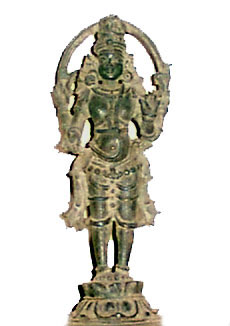 |
| .
Brahma
Locality not
Known. About 15th Century AD.
The four faces are united at the ears, of which there are likewise
four, each bearing a large pyriform pendent. They are surmounted by four kirita-makutas
combined into one. There are two slender beaded necklaces. The sacred thread divides into four
parts, of which the two outermost are short, beaded and incomplete; the inner two parts which
are simple, reach down to the loin cloth on either side of the body, that on the right passing
round and across the back to the left shoulder in the usual way. The prabha is double
arched with flame ornaments on its lower edge. It arises from a pair of short and strongly
curved makaras, and is surmounted by a yali-head carrying a flame ornament.
In his four hands he holds Rosary, Kamandalu; Abhaya and Varada. |

|

|
Chandrasekara
Triutturaippundi
Taluk, Tanjore District. Height 27 cm. About 12th century AD.
The image is in
somewhat curious style but cruder and much elaborate. A snake is coiled round the head dress,
above the jewel that decorates the middle of its base in front and below the crescent. A face
looks out from the left side of the head-dress above the snake and a similar one from the
right earring. A snake is coiled round each wrist, hanging down over the hand. The sacred
thread is twisted once round the waist band, the sides of which are joined by a pair of bands
to a pendant hanging between the breasts from the lower necklace. Another short band joins the
upper end of the right hand of one of these bands with the middle of the waist-band where the
sacred thread twists round it. The tail and the face of the antelope are facing towards Siva.
|
..
Chandikesvara
Nidur, Mayavarm Taluk, Tanjore District.
About 12th century AD. Height 53cm.
Makara-Kundalas.
Hands in anjali groove on upper part of left arm in which axe should evidently fit
in.
Chandikesvara differs from the rest in the collection and
resembles the rest in ear rings. The general treatment, including that of the necklaces,
suggests that is should perhaps be regarded as of Chola type, though there is no
trace of projecting elbow ornaments.
|
 |
|
 |
|